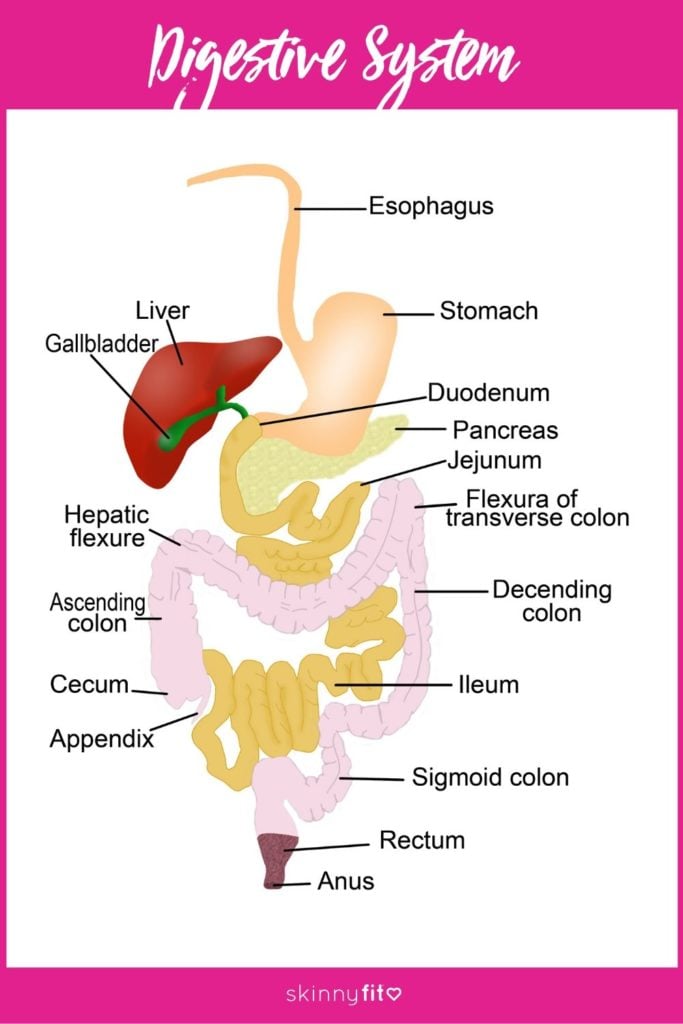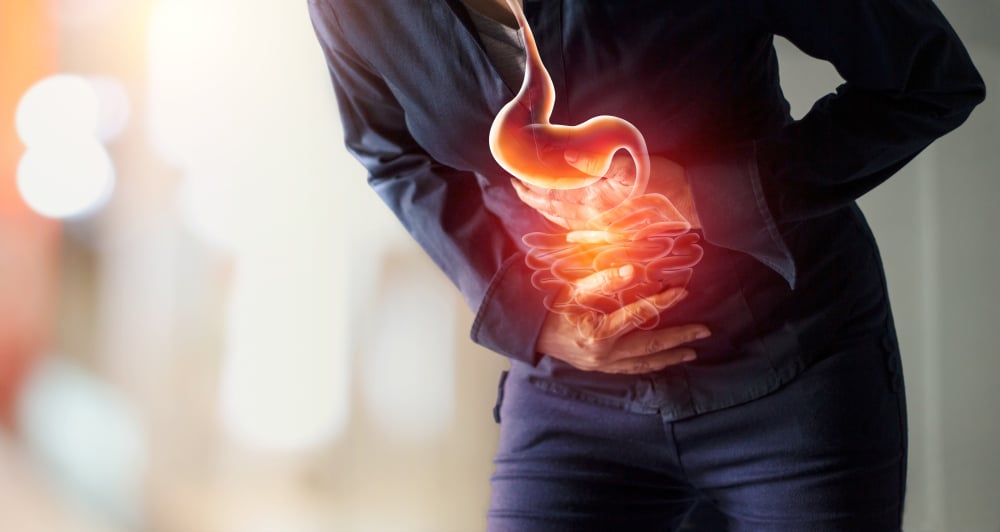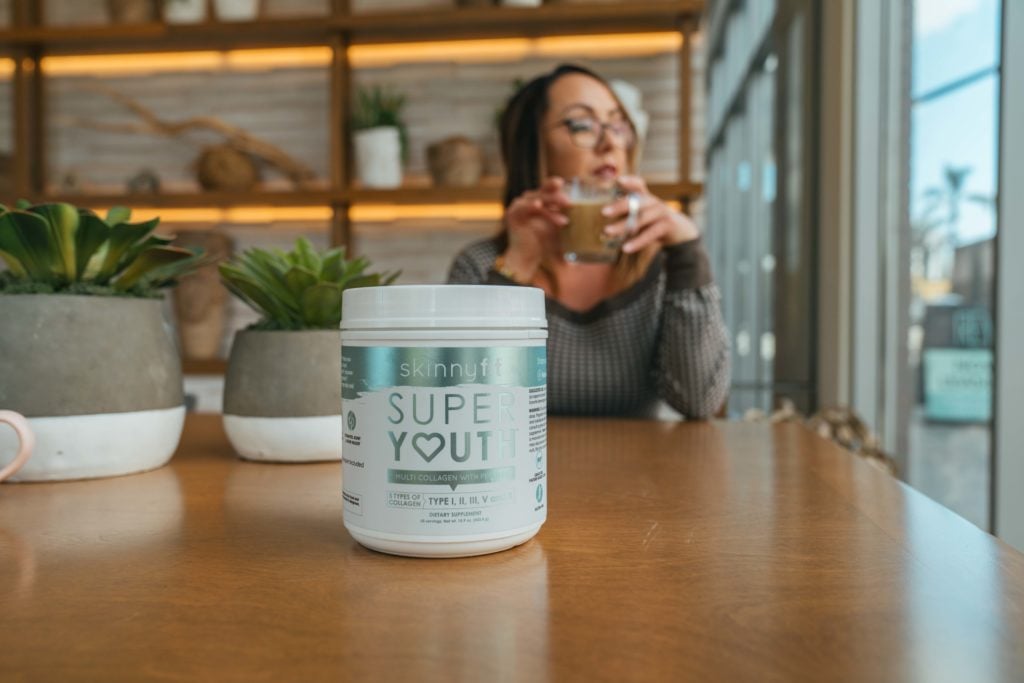One of the hardest things to pinpoint in the body is the cause of gastrointestinal distress. The stomach is a large, complicated organ and things can get messy when you throw together food, liquids, stomach acids, and good and bad bacteria!
If you’re feeling something rumbling in your tummy or you’re interested in finding out what you can do to prevent pesky stomach problems from popping up, this blog is for you.
Article at a glance:
- What is gastrointestinal distress?
- How does the digestive system work?
- Symptoms of GI distress
- Causes
- Treatment & remedies

What Is Gastrointestinal Distress (GI Distress)?
No one is immune to gastrointestinal distress (also called GI distress, gastric distress, or digestive issues). The symptoms can strike at virtually any moment they can be … welp, a real buzz-kill. If you’ve ever experienced tummy issues you know that it can make you feel embarrassed and quite often, stressed. One of the simplest ways to handle GI distress is by preventing it from happening in the first place. Easier said than done, right? But you’re in luck because this blog will help give you the tools to prepare yourself with gastric distress remedies so you stay in the clear. You’re about to see how just a few simple adjustments can go a long way.
How Does The Digestive System Work?
Before we get too far into the GI tract, let’s back it up and answer the question, how does digestion work? Welp, digestion can be as simple or as complicated as you’re willing to make it, but essentially, it is the process of breaking down food and liquid into smaller and smaller pieces so that your body can absorb nutrients and eliminate waste.
Do you remember the show the Magic School Bus? In one episode, Ms. Frizzle jumps into a student’s mouth and the class takes a field trip through the digestive system. The students sail on the stomach acids as they observe the digestion process that a Cheezie Wheezie takes. They get to see first-hand how the food is chewed, swallowed, and sent to sail through the esophagus and then into the small intestine. From there, the tiny food particles enter the bloodstream and travel to all of the parts of the body that need them. The waste is eliminated by the large intestine.
The process Ms. Frizzle showed her students was the way food moved through the GI tract. This process is also called peristalsis. The layer of muscle that surrounds the hollow tube connecting your mouth to your anus, as well as your liver, pancreas, gallbladder, and small and large intestine, pushes food and liquid forward. Some of the muscles squeeze food through, while other muscles are responsible for relaxing so that the food can flow freely.

Why do I experience gastro distress?
When you have so many moving parts (literally!), things can get messy. Sometimes the digestion process gets knocked off balance because of food, stress, allergies, infections, diet, lifestyle, or more serious conditions like celiac disease. Take a few moments and ask yourself about your stomach health. How often do you deal with bloating and pain? The problem often relates to an underlying issue.
GI distress symptoms usually involve: (1)
- Gas/bloating
- Cramping
- Constipation/diarrhea
- Stomach pain
If you are experiencing gastrointestinal distress and digestive issues, read on for things you can do to prevent uncomfortable feelings.
Gastrointestinal Distress Symptoms & Causes
Below are some of the most common gastrointestinal distress symptoms and causes. Did you know that collagen makes up the majority of the intestinal wall? To help keep the lining of your stomach strong, consume a collagen protein regularly. Not only does collagen have a beneficial effect on the function of your GI tract, but it also helps to build and maintain the tissue that lines the entire digestive tract. This can help you avoid problems like leaky gut and gut inflammation. (2)
1. Gas/Bloating
Bloating can be a real b*tch, and put a total damper on your day. But I’m going to challenge you to look at bloating in a new light: As an SOS from your digestive system. Bloating is the equivalent of a party planner tapping you on the shoulder and pointing to the guy who just walked onto your white carpet with muddy shoes. Bloating is an ‘uh oh’ and it signals that something is wrong. It’s a physical cue from your insides that things are not going… as planned.
What causes gas and bloating?
It’s normal to feel a bit of fullness in the belly after eating, but ongoing bloating can usually be traced back to digestive issues that don’t involve food or alcohol, including:
- Stress: More and more research is emerging about the relation between our gut and our emotional states. Stressful situations can stimulate the gut and worsen bloating, constipation, and diarrhea.
- Eating too fast: I know that plate of gnocchi from your favorite restaurant NEEDS to be inhaled immediately (and, yes, I’m talking from experience), but slow down sister. Start a practice of mindful eating. Appreciate your food and bring your senses to the color, texture, and smell of the food as you take small bites. Chew slowly and focus on each bite. Eating mindfully will enhance every meal. Trust me. Chewing helps the body digest properly, so make sure you’re taking enough bites to grind up your food properly. Your GI tract will thank you. (3)
- Not drinking enough water or drinking too much: Ah, the elixir of life. Drinking water is the cheapest beauty trick in the book. If you’re not drinking enough water during the day and you’re feeling bloated after meals, start upping your H20 intake… like a lot. When your body feels dehydrated it retains fluids to keep you ALIVE! On the flip side, drinking too much water with a meal can lead to bloating. So, just find the balance and stay appropriately hydrated. A good rule of thumb when it comes to getting enough water is to drink half of your body weight in ounces of water. For example, if you weigh 150 lbs, you should aim to drink 75 ounces of water daily and more if you are in a warmer climate or you’re highly active.
2. Diarrhea
The main symptom of diarrhea is having watery, loose stools more than 3 times a day. Blame it on your period. Or the nacho cheese fries you ate last night. To stop the runs, you can do a few things: See a doctor, drink more water, or eat plain foods like bananas, rice, and toast. (4)
What causes diarrhea?
The causes of diarrhea include but are not limited to: (4)
- Infections
- Side effects of medicines
- Food allergies and intolerances
- Digestive tract problems
3. Constipation
We each have patterns of how often we “go” that varies from person to person. Your bowel movement pattern is unique to you, but once you start straying from your pattern too far—in either direction (constipation or diarrhea) is when trouble starts.
As one of the most common digestive issues, constipation is one stomach problem that most of us are pretty familiar with. It usually comes and goes, but chronic constipation can be trouble. Constipation is defined as having less than three bowel movements a week and when you do pass a stool, it is hard, dry, or lumpy. (5)
What causes constipation?
Constipation is not a medical condition in and of itself. It’s usually a sign that something else is up in the body and the symptoms can last for a short time or a long time. Constipation is one of the most common gastrointestinal conditions. When you’re constipated, food moves slowly through the digestive tract, giving your colon a lot of time to absorb water from the stool. This causes the stool to dry out and makes it difficult to move along. (6)

4. Heartburn/GERD
Heartburn caused by gastroesophageal reflux disease (GERD) is that fiery feeling in your chest after you’ve eaten certain foods, like vinegar, spicy foods, tomato sauce, and fatty or fried foods.
What causes heartburn/ GERD?
Your GI tract contains an acid that helps break down food into smaller pieces. When this acid gets backed up it goes into your esophagus, which is the part of the tube that connects your mouth and stomach, and this causes… you guessed it, heartburn. GERD can leave you with a sore throat, tightness in your chest, trouble swallowing, nausea, or a sour taste in your mouth. (7)
5. Stomach pain/cramps
Stomach pains are common and because the stomach is such a large organ, it can be hard to pinpoint why you’re experiencing cramps. If you’re on your period it’s easier to figure out where they’re coming from, but if it’s a normal day it can be a little harder.
What causes stomach pain/cramps?
Stomach pain is super common, but where does it come from? There are a number of reasons for GI distress in the form of stomach pain and cramps, including: (8)
- Stomach virus
- Constipation
- Irritable bowel syndrome
- Lactose intolerance
- Food poisoning
- Food allergies
The stomach is connected to the brain and if you’re feeling stressed, it’s probable that the stress is manifesting in other parts of your body—like your gut.
Serious stomach pain can be the symptom of a more serious problem like: (8)
- Ulcers
- Kidney stones
- Bowel blockage
- Appendicitis
- Gallstones
- Cancer
- Gastroesophageal reflux
- Abdominal aortic aneurysm
If you’re having sharp or severe abdominal pain, it’s best to have it looked at by a doctor.
Gastric Distress Remedies
1. Take a pre- and probiotic supplement
Probiotics are live cultures that help balance the good and bad bacteria in our gut. I like to think of pre and probiotics like really cool mall security guards who always have your back. They’re busy inside your stomach trying to get everyone to stay in line. By taking a daily pre and probiotic, you help your skin become stronger, happier, and healthier. Probiotics help fight gut inflammation and keep the body healthy.
When you eat foods that throw off the balance of pre and probiotics, it can result in gastric distress. This imbalance of good and bad bacteria in the gut can manifest as major tummy problems. Taking a good quality pre and probiotic like SkinnyFit Belly Balance can help reduce unbeneficial specimens hanging around in your gut and unleash those fun mall cops. This formula is designed to help calm bloating, improve digestion, fight inflammation, and soothe the intestinal tract.
One of the greatest gastric distress remedies is a daily supplement like SkinnyFit Skinny Greens or SkinnyFit Beauty Juice. Simply mix a scoop into your water or smoothie and rest assured that your digestion is operating at an optimum level.

2. Eat more fiber
Another one of my favorite gastric distress remedies is FIBER! Fiber doesn’t sound as sexy as a pre or probiotics, but it is very important for a healthy diet. Fiber helps you feel full and helps regulate your bowel movements. There are two types of fiber: Soluble and insoluble. Soluble fiber is found in foods like: (9)
- Beans
- Lentils
- Oats
- Barley
Insoluble fiber is found in foods like:
- The skin of fruits and vegetables
- Wheat bran
- Whole grain breads and cereals
Eating a healthy diet of fiber can even help improve cholesterol and blood sugar levels to keep your system running smoothly. (10)
3. Add collagen to your routine
Age-old gastric distress remedies like drinking bone broth go back centuries when people used to brew bones and meat to get the gelatin protein that would help their stomach lining. Luckily, you can skip the brewing bones part and opt for an easy to drink collagen protein that will help strengthen the intestinal wall. (11)
Collagen is the most abundant protein in the body and taking a daily collagen supplement can help repair damage to the gut. Collagen acts as a glue in the body and can help keep the stomach lining strong and prevent conditions like leaky gut syndrome. Collagen helps soothe inflammation in the lining of the gut to keep you healthy.
Specifically, Type V collagen helps to restore the tissue in the lining of your stomach as well as your vital organs and bone matrix. SkinnyFit Super Youth collagen contains all 5 types of collagen, including Type V. To learn more about the science that supports why Type V collagen is the best collagen you can take for gut health, check out Collagen For Leaky Gut.
The Bottom Line On GI Distress
So what’s the skinny on gastrointestinal distress? Your body is smart. Trust it. Your body has smart ways to tell you how to balance your lifestyle so that your body doesn’t have to strain so much. It’s much easier to prevent GI distress than to battle the effects of it. Taking a pre- and probiotic supplement, like Belly Balance, can help you stay ahead of gastro distress. Especially when used in combination with a daily collagen supplement, like Super Youth, which can keep your gut healthy, happy, and thriving!
